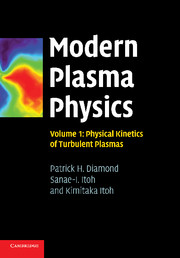Book contents
- Frontmatter
- Contents
- Preface
- Acknowledgements
- 1 Introduction
- 2 Conceptual foundations
- 3 Quasi-linear theory
- 4 Nonlinear wave–particle interaction
- 5 Kinetics of nonlinear wave–wave interaction
- 6 Closure theory
- 7 Disparate scale interactions
- 8 Cascades, structures and transport in phase space turbulence
- 9 MHD turbulence
- Appendix 1 Charney–Hasegawa–Mima equation
- Appendix 2 Nomenclature
- References
- Index
1 - Introduction
Published online by Cambridge University Press: 05 October 2010
- Frontmatter
- Contents
- Preface
- Acknowledgements
- 1 Introduction
- 2 Conceptual foundations
- 3 Quasi-linear theory
- 4 Nonlinear wave–particle interaction
- 5 Kinetics of nonlinear wave–wave interaction
- 6 Closure theory
- 7 Disparate scale interactions
- 8 Cascades, structures and transport in phase space turbulence
- 9 MHD turbulence
- Appendix 1 Charney–Hasegawa–Mima equation
- Appendix 2 Nomenclature
- References
- Index
Summary
The beginning is the most important part of the work.
(Plato)In this introduction, we set out directly to answer the many questions the reader may have in mind about this book, such as:
(1) Why is this book being written? Why study theory in the age of high performance computing and experimental observations in unparalleled detail? In what way does it usefully augment the existing literature? Who is the target readership?
(2) What does it cover? What is the logic behind our particular choice of topics? Where will a reader stand and how will he or she benefit after completing this book?
(3) What is not included and why was it omitted? What alternative sources are recommended to the reader?
We now proceed to answer these questions.
Why?
Surely the need for study of plasma turbulence requires no explanation.
Turbulence pervades the dynamics of both laboratory and astrophysical plasmas. Turbulent transport and its associated confinement degradation are the main obstacles to achieving ignition in magnetically confined plasma (i.e., for magnetic confinement fusion (MCF) research), while transport bifurcations and self-generated shear flows are the principal means for controlling such drift wave turbulence. Indeed, predictions of degradation of confinement by turbulence have been used to (unjustifiably) challenge plans for ITER (International Thermonuclear Experimental Reactor).
- Type
- Chapter
- Information
- Modern Plasma Physics , pp. 1 - 17Publisher: Cambridge University PressPrint publication year: 2010



